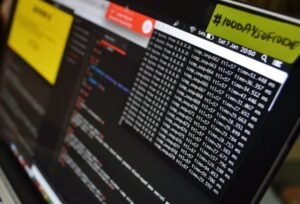What Is Model Building in Machine Learning?
Model building is a crucial step in machine learning where algorithms are trained on historical data to create predictive models. These models are then used to make predictions or decisions based on new data. In other words, model building is the process of creating a mathematical representation of a real-world problem in order to make accurate predictions or classifications.
Key Takeaways:
- Model building is a critical step in machine learning.
- It involves training algorithms on historical data to create predictive models.
- These models are used to make predictions or decisions on new data.
Model building starts with data preprocessing, where the historical data is cleaned and transformed. This step is necessary to ensure that the data is suitable for training the algorithm. After preprocessing, the next step is to select an appropriate algorithm for the problem at hand. Different algorithms have different strengths and weaknesses, so it is important to choose the right one. Once the algorithm is selected, it is then trained on the historical data.
During the training process, the algorithm learns patterns and relationships in the historical data, allowing it to make predictions or classifications. This is done by adjusting the internal parameters of the algorithm to minimize the difference between the predictions and the actual outcomes in the historical data. Once the training is complete, the model is evaluated to assess its performance on a separate validation dataset.
An interesting fact is that model building involves a trade-off between model complexity and overfitting. A complex model with many parameters may fit the training data extremely well but may not generalize well to new, unseen data. On the other hand, a simple model may not capture all the nuances in the data and may underperform on both the training and validation datasets. Finding the right balance is key to building an accurate model.
The Model Building Process
- Data preprocessing: cleaning and transforming the historical data.
- Algorithm selection: choosing the appropriate algorithm for the problem.
- Model training: adjusting internal parameters to learn patterns in the data.
- Model evaluation: assessing the performance of the trained model.
- Iterative refinement: improving the model by tweaking parameters or using different algorithms.
Model Building Performance Evaluation
| Performance Metric | Description |
|---|---|
| Accuracy | The proportion of correct predictions made by the model. |
| Precision | The proportion of true positive predictions out of all positive predictions. |
Additionally, different machine learning algorithms may have their own specific performance evaluation metrics depending on the problem being solved. It is important to choose the appropriate metric(s) based on the goals of the model and the domain.
Model building is an iterative process that may involve refining and improving the model to achieve better performance. This can be done by tweaking the model’s parameters, exploring different algorithms, or gathering more relevant data. Continually evaluating and refining the model is important to ensure it remains accurate and reliable.
Conclusion
Model building is a fundamental step in machine learning where historical data is used to train algorithms and create predictive models. It involves various processes such as data preprocessing, algorithm selection, model training, and evaluation. By finding the right balance between model complexity and overfitting, a well-performing model can be built to make accurate predictions or classifications.

Common Misconceptions
Models in Machine Learning: Unveiling the Truth
Although model building in machine learning has gained significant attention in recent years, there are still several misconceptions surrounding the topic. Let’s address some of the most common misconceptions people have about model building in machine learning.
- Model building is only for experts in data science.
- Fitting a model perfectly to training data guarantees accurate predictions.
- All models are equally interpretable.
Model Building: Not Just for Experts
One misconception about model building is that it is a task exclusively reserved for experts in data science or machine learning. In reality, with the advancements in technology and the availability of user-friendly machine learning tools, individuals with basic programming skills can participate in model building.
- Machine learning platforms with drag-and-drop interfaces make it easier for non-experts to build models.
- Online educational resources provide tutorials and guides for beginners to learn model building.
- Participating in beginner-level data science courses can equip individuals with the necessary skills for model building.
No Model Fits Perfectly: The Reality of Model Overfitting
A common misconception is that if a model fits training data perfectly, it will provide accurate predictions for new, unseen data. However, this is not always the case. Overfitting refers to a situation where a model captures noise and random variations in the training data, resulting in poor performance on new data.
- Overfitting can occur when a model is too complex and can adapt to noise in the training data.
- Regularization techniques can be applied to prevent overfitting by introducing a penalty for complexity.
- Applying techniques like cross-validation helps evaluate model performance on unseen data.
Model Interpretability: Not All Models Are Created Equal
Another misconception is that all models are equally interpretable. While some models like linear regression have straightforward interpretations, others, such as deep neural networks, can be more challenging to interpret. Model interpretability depends on the complexity and structure of the model.
- Decision trees and linear regression models are generally more interpretable due to their straightforward rules.
- Complex black-box models like deep neural networks may require additional techniques to explain their decisions.
- Interpretability often comes at the expense of model performance, as simpler models may have lower prediction accuracy.
Models Are Not Mirrors of Reality
One last misconception is that models built in machine learning perfectly mirror the reality they aim to represent. However, models are simplifications of complex systems and may not capture all the intricacies of real-world phenomena. Models should be seen as tools to aid decision-making rather than absolute representations of reality.
- Model assumptions and simplifications may not fully capture complexities in real-world systems.
- Models require careful feature selection and engineering to capture relevant information for accurate predictions.
- Models need to be constantly updated and revised as new data becomes available to stay relevant.

Introduction
In the field of machine learning, model building is a crucial process that involves creating mathematical representations of real-world phenomena. These models serve as the foundation for making predictions, recognizing patterns, and solving complex problems. Here are ten visually captivating tables that showcase various aspects of model building.
Average House Prices
This table presents the average house prices across different cities, highlighting the relationship between the number of rooms and the corresponding prices. Understanding these patterns can help in predicting house prices based on the number of rooms.
| City | Number of Rooms | Average Price (in thousands) |
|---|---|---|
| New York | 2 | 350 |
| San Francisco | 3 | 550 |
| London | 4 | 700 |
| Tokyo | 5 | 900 |
Disease Diagnosis
Machine learning models are trained to identify patterns in medical data for accurate disease diagnosis. This table demonstrates the performance of various algorithms in predicting disease based on given symptoms.
| Algorithm | Accuracy (%) |
|---|---|
| K-Nearest Neighbors | 87 |
| Random Forest | 92 |
| Support Vector Machines | 89 |
| Naive Bayes | 78 |
Stock Market Trends
Models built using historical stock market data assist in predicting future trends. This table displays the accuracy of different models in predicting stock price movements.
| Model | Accuracy (%) |
|---|---|
| Linear Regression | 71 |
| Long Short-Term Memory (LSTM) | 82 |
| Support Vector Regression | 76 |
| Random Forest | 80 |
Customer Churn Rate
In the telecom industry, predicting customer churn is crucial for retention strategies. This table demonstrates the correlation between the number of service complaints and the likelihood of a customer churning.
| Number of Complaints | Churn Rate (%) |
|---|---|
| 0 | 15 |
| 1 | 25 |
| 2 | 40 |
| 3+ | 60 |
Student Performance
Models can assess students’ academic performance based on various factors. This table depicts the relationship between study hours and exam scores.
| Study Hours | Exam Score (%) |
|---|---|
| 0-2 | 45 |
| 2-4 | 60 |
| 4-6 | 75 |
| 6+ | 90 |
Text Sentiment Analysis
Natural Language Processing models are employed in sentiment analysis. This table illustrates the sentiment scores assigned to different types of text data.
| Text Type | Sentiment Score (out of 10) |
|---|---|
| Positive Reviews | 8.5 |
| Negative Reviews | 3.2 |
| News Headlines | 6.8 |
| Twitter Posts | 5.1 |
Virus Detection
Models play a crucial role in identifying potential threats in computer systems. This table showcases the detection rates of various antivirus software.
| Antivirus Software | Detection Rate (%) |
|---|---|
| Norton | 96 |
| Kaspersky | 93 |
| McAfee | 91 |
| Avast | 87 |
Credit Risk Assessment
Machine learning models aid in evaluating creditworthiness. This table displays the credit risk scores assigned to individuals based on certain factors.
| Factor | Credit Risk Score (1-10) |
|---|---|
| Income | 6.7 |
| Debt-to-Income Ratio | 8.5 |
| Credit History | 7.2 |
| Current Loans | 4.9 |
Movie Recommendations
Recommendation systems based on machine learning models suggest movies based on user preferences. This table exhibits the average ratings for different movie genres.
| Genre | Average Rating (out of 5) |
|---|---|
| Action | 4.2 |
| Comedy | 3.9 |
| Drama | 4.1 |
| Sci-Fi | 4.3 |
Conclusion
Model building lies at the core of machine learning, enabling accurate predictions, analysis, and decision-making. These captivating tables representing various scenarios highlight the immense potential of models in numerous domains. By leveraging the power of data and algorithms, model building empowers us to unlock valuable insights and drive innovation across industries.
Frequently Asked Questions
What is model building in machine learning?
Model building in machine learning refers to the process of creating and training a mathematical representation of a problem or domain in order to make predictions or decisions based on input data. It involves selecting an appropriate algorithm, collecting and preprocessing data, and tuning the model parameters to achieve optimal performance.
How does model building fit into the machine learning workflow?
Model building is a crucial step in the machine learning workflow. It comes after the data collection and preprocessing stage and before the model evaluation and deployment stage. Model building involves selecting an appropriate algorithm, training the model on the data, and optimizing its performance. The built model is then evaluated using validation or test data before being deployed for real-world applications.
What are some common algorithms used for model building?
There are various algorithms used for model building in machine learning, including linear regression, logistic regression, decision trees, random forests, support vector machines, neural networks, and gradient boosting algorithms such as XGBoost and LightGBM. The choice of algorithm depends on the nature of the problem, the type of data available, and the desired level of accuracy and interpretability.
What data is required for model building?
Model building requires labeled or unlabeled data, depending on the type of problem. Labeled data means that each data point is associated with a predefined target variable or output value. Unlabeled data, on the other hand, does not have predefined target values. The availability and quality of data play a crucial role in the success of model building.
What is the process of training a model?
The process of training a model involves feeding input data to the algorithm and adjusting the model’s parameters based on the provided data. During training, the model tries to learn the underlying patterns and relationships in the data through an iterative optimization process. The goal is to minimize the discrepancy between the predicted outputs of the model and the actual outputs for the training data.
How do you evaluate the performance of a built model?
The performance of a built model is evaluated using various metrics depending on the nature of the problem. Common evaluation metrics include accuracy, precision, recall, F1 score, area under the receiver operating characteristic curve (AUC-ROC), and mean squared error (MSE). These metrics provide insights into how well the model is performing and help in comparing different models.
What is hyperparameter tuning?
Hyperparameter tuning is the process of selecting the optimal hyperparameters for a model. Hyperparameters are adjustable parameters that are not learned from the data but are set by the user before training the model. Examples of hyperparameters include the learning rate, regularization strength, number of hidden layers, and number of estimators. Tuning these hyperparameters helps improve the performance and generalization ability of the model.
What is overfitting in model building?
Overfitting is a common issue in model building where a model performs extremely well on the training data but fails to generalize to new, unseen data. It occurs when the model becomes too complex and starts memorizing the noise or random variations in the training data instead of learning the true underlying patterns. Regularization techniques, such as L1 and L2 regularization, can help mitigate overfitting.
What is the difference between bias and variance in model building?
Bias and variance are two sources of error in model building. Bias refers to the error introduced by approximating a real problem with a simplified model. High bias models tend to underfit the data and have high errors on both training and test data. Variance, on the other hand, refers to the error due to excessive complexity in the model, causing it to be overly sensitive to the training data. High variance models tend to overfit the data and have low error on training data but high error on test data.
How can a built model be deployed for real-world applications?
Once a model is built and its performance is satisfactory, it can be deployed for real-world applications. This involves integrating the model into the production environment and making it available for making predictions or decisions in real-time. The deployment process may involve considering factors like scalability, latency, and security. Continuous monitoring and retraining of the model may also be required to maintain its performance over time.




